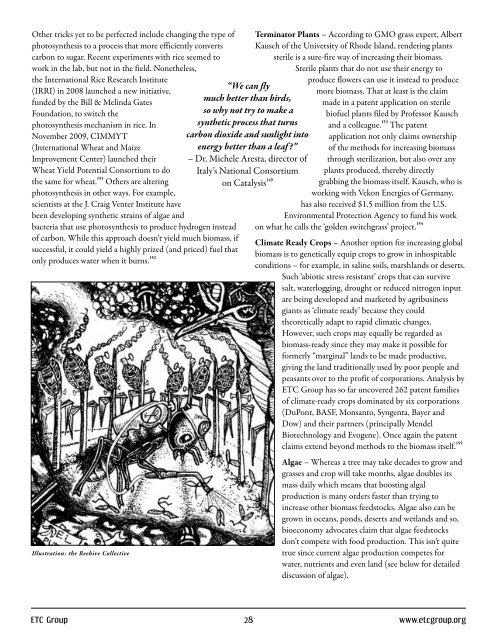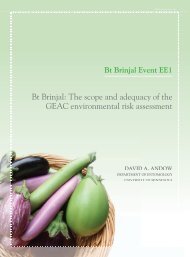English - pdf - 2145 Kb - Biosafety Information Centre
English - pdf - 2145 Kb - Biosafety Information Centre
English - pdf - 2145 Kb - Biosafety Information Centre
- No tags were found...
You also want an ePaper? Increase the reach of your titles
YUMPU automatically turns print PDFs into web optimized ePapers that Google loves.
Other tricks yet to be perfected include changing the type ofphotosynthesis to a process that more efficiently convertscarbon to sugar. Recent experiments with rice seemed towork in the lab, but not in the field. Nonetheless,the International Rice Research Institute(IRRI) in 2008 launched a new initiative,funded by the Bill & Melinda GatesFoundation, to switch thephotosynthesis mechanism in rice. InNovember 2009, CIMMYT(International Wheat and MaizeImprovement Center) launched theirWheat Yield Potential Consortium to dothe same for wheat. 151 Others are alteringphotosynthesis in other ways. For example,scientists at the J. Craig Venter Institute havebeen developing synthetic strains of algae andbacteria that use photosynthesis to produce hydrogen insteadof carbon. While this approach doesn’t yield much biomass, ifsuccessful, it could yield a highly prized (and priced) fuel thatonly produces water when it burns. 152Illustration: the Beehive Collective“We can flymuch better than birds,so why not try to make asynthetic process that turnscarbon dioxide and sunlight intoenergy better than a leaf ?”– Dr. Michele Aresta, director ofItaly’s National Consortiumon Catalysis 149Terminator Plants – According to GMO grass expert, AlbertKausch of the University of Rhode Island, rendering plantssterile is a sure-fire way of increasing their biomass.Sterile plants that do not use their energy toproduce flowers can use it instead to producemore biomass. That at least is the claimmade in a patent application on sterilebiofuel plants filed by Professor Kauschand a colleague. 153 The patentapplication not only claims ownershipof the methods for increasing biomassthrough sterilization, but also over anyplants produced, thereby directlygrabbing the biomass itself. Kausch, who isworking with Vekon Energies of Germany,has also received $1.5 million from the U.S.Environmental Protection Agency to fund his workon what he calls the ‘golden switchgrass’ project. 154Climate Ready Crops – Another option for increasing globalbiomass is to genetically equip crops to grow in inhospitableconditions – for example, in saline soils, marshlands or deserts.Such ‘abiotic stress resistant’ crops that can survivesalt, waterlogging, drought or reduced nitrogen inputare being developed and marketed by agribusinessgiants as ‘climate ready’ because they couldtheoretically adapt to rapid climatic changes.However, such crops may equally be regarded asbiomass-ready since they may make it possible forformerly “marginal” lands to be made productive,giving the land traditionally used by poor people andpeasants over to the profit of corporations. Analysis byETC Group has so far uncovered 262 patent familiesof climate-ready crops dominated by six corporations(DuPont, BASF, Monsanto, Syngenta, Bayer andDow) and their partners (principally MendelBiotechnology and Evogene). Once again the patentclaims extend beyond methods to the biomass itself. 155Algae – Whereas a tree may take decades to grow andgrasses and crop will take months, algae doubles itsmass daily which means that boosting algalproduction is many orders faster than trying toincrease other biomass feedstocks. Algae also can begrown in oceans, ponds, deserts and wetlands and so,bioeconomy advocates claim that algae feedstocksdon’t compete with food production. This isn’t quitetrue since current algae production competes forwater, nutrients and even land (see below for detaileddiscussion of algae).ETC Group 28 www.etcgroup.org











